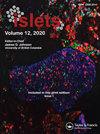Short-chain fatty acids and regulation of pancreatic endocrine secretion in mice
IF 1.7
4区 医学
Q3 ENDOCRINOLOGY & METABOLISM
引用次数: 20
Abstract
ABSTRACT The intestinal microbiota has been demonstrated to influence host metabolism, and has been proposed to affect the development of obesity and type 2 diabetes (T2D), possibly through short-chain fatty acids (SCFAs) produced by fermentation of dietary fiber. There are some indications that SCFAs inhibit glucose-stimulated insulin secretion (GSIS) in rodents, but research on this subject is sparse. However, it has been reported that receptors for SCFAs, free fatty acid receptor 2 (FFAR2) and FFAR3 are expressed not only on gut endocrine cells secreting GLP-1 and PYY, but also on pancreatic islet cells. We hypothesized that SCFAs might influence the endocrine secretion from pancreatic islets similar to their effects on the enteroendocrine cells. We studied this using isolated perfused mouse pancreas which responded adequately to changes in glucose and to infusions of arginine. None of the SCFAs, acetate, propionate and butyrate, influenced glucagon secretion, whereas they had weak inhibitory effects on somatostatin and insulin secretion. Infusions of two specific agonists of FFAR2 and FFAR3, CFMB and Compound 4, respectively, did not influence the pancreatic secretion of insulin and glucagon, whereas both induced strong increases in the secretion of somatostatin. In conclusion, the small effects of acetate, propionate and butyrate we observed here may not be physiologically relevant, but the effects of CFMB and Compound 4 on somatostatin secretion suggest that it may be possible to manipulate pancreatic secretion pharmacologically with agonists of the FFAR2 and 3 receptors, a finding which deserves further investigation.短链脂肪酸与小鼠胰腺内分泌分泌的调节
肠道微生物群已被证明影响宿主代谢,并被认为可能通过膳食纤维发酵产生的短链脂肪酸(SCFAs)影响肥胖和2型糖尿病(T2D)的发展。有一些迹象表明,SCFAs抑制啮齿动物葡萄糖刺激胰岛素分泌(GSIS),但这方面的研究很少。然而,据报道,SCFAs的受体,游离脂肪酸受体2 (FFAR2)和FFAR3不仅在分泌GLP-1和PYY的肠内分泌细胞上表达,而且在胰岛细胞上表达。我们假设SCFAs可能影响胰岛的内分泌分泌,类似于它们对肠内分泌细胞的影响。我们使用分离的小鼠胰腺进行了研究,该胰腺对葡萄糖的变化和精氨酸的注入有充分的反应。乙酸酯、丙酸酯和丁酸酯均不影响胰高血糖素的分泌,而对生长抑素和胰岛素的分泌有微弱的抑制作用。分别输注FFAR2和FFAR3两种特异性激动剂CFMB和Compound 4,不影响胰腺胰岛素和胰高血糖素的分泌,但均诱导生长抑素分泌强烈增加。综上所述,我们在这里观察到的醋酸酯、丙酸酯和丁酸酯的小作用可能与生理无关,但CFMB和化合物4对生长抑素分泌的影响表明,FFAR2和3受体的激动剂可能在药理学上操纵胰腺分泌,这一发现值得进一步研究。
本文章由计算机程序翻译,如有差异,请以英文原文为准。
求助全文
约1分钟内获得全文
求助全文
来源期刊

Islets
ENDOCRINOLOGY & METABOLISM-
CiteScore
3.30
自引率
4.50%
发文量
10
审稿时长
>12 weeks
期刊介绍:
Islets is the first international, peer-reviewed research journal dedicated to islet biology. Islets publishes high-quality clinical and experimental research into the physiology and pathology of the islets of Langerhans. In addition to original research manuscripts, Islets is the leading source for cutting-edge Perspectives, Reviews and Commentaries.
Our goal is to foster communication and a rapid exchange of information through timely publication of important results using print as well as electronic formats.
 求助内容:
求助内容: 应助结果提醒方式:
应助结果提醒方式:


